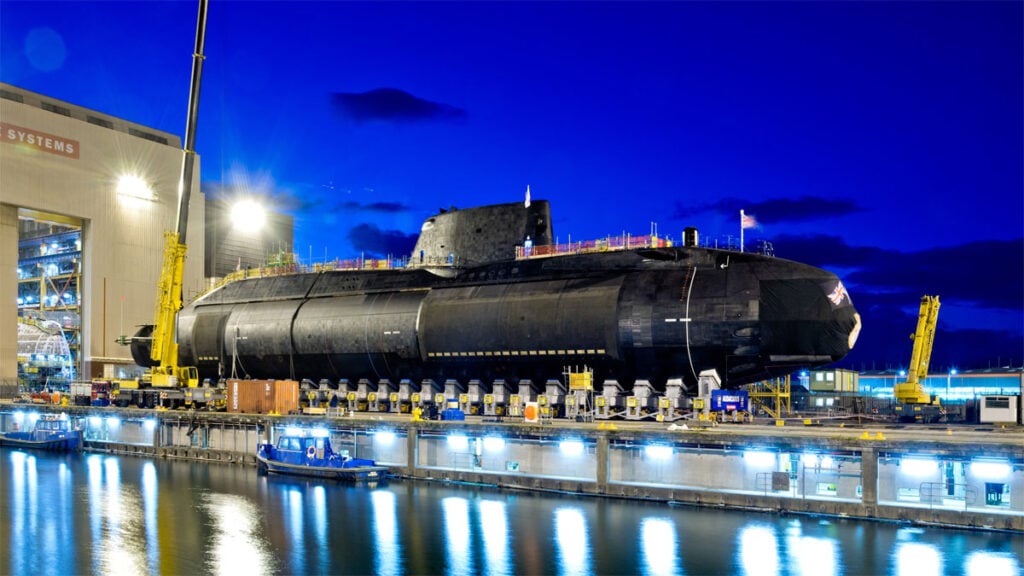
Astute class Audacious nuclear powered attack submarine. (BAE Systems)
WASHINGTON: In light of remarks by the top Australian admiral in charge of the plan to buy nuclear powered attack submarines, the British Astute design looks like it may be the frontrunner over an American capability.
The head of Australia’s nuclear submarine taskforce, Vice Adm. Jonathan Mead, told a Senate committee last week that his country intends to select a “mature design” for its nuclear submarine, to be built under the AUKUS security partnership, as reported by the Australian Broadcasting Corporation.
“It is our intention that when we start the build program, the design will be mature and there will be a production run already in existence,” Mead told a hearing in Canberra about what Australia calls “estimates,” which is basically their term for the budget.
Brent Sadler, a former nuclear submariner who served in the Indo-Pacific theater, said Australia knows “that a completely indigenously built sub with a new Australian design would be a 15- to 20-year endeavor.”
“They’ve realized they need submarines sooner than that,” Sadler, a sub expert at the Heritage Foundation, told Breaking Defense. “If you follow the math and the engineering, then that’s the logical conclusion if you want a sub before 2035.”
While Mead said “all options are on the table” as far as the sub’s design goes, Sadler thought the British Royal Navy’s Astute class submarine “makes the most sense.” This may well be the main reason that the United Kingdom was included in the new defense agreement.
This doesn’t necessarily mean all the Australian boats will be built by Britain, Sadler said. The probable approach — the one that will meet the requirement for a mature production line — would be to build the first two in Britain and then one or two in Australia. There’s tremendous domestic political pressure to build as much as possible in the Lucky Country, but the Australian government is facing extensive difficulties with current shipbuilding.
The Australian Broadcasting Corp. reported in August that “every major Australian naval shipbuilding project is now considered to be running late, including the $90 billion future submarines project and the $45 billion development of a fleet of Hunter-class frigates.
“Even the relatively simpler and smaller project to construct a $4 billion fleet of offshore patrol vessels is behind schedule,” ABC said.
Building nuclear submarines, with the highly sophisticated and unique welding requirements, the advanced physical security needed, plus the much greater size of the nuke boats means Australia would have to take years to either build new facilities or expand and refine those that will be required to improve and extend the life of the Collins class submarines.
Those modified Collins subs will require extended hulls, so that may take care of some of the changes needed.
“There’s an opportunity in there to fix any problems they have with the logistics and fabrication and shipyard elements, while at the same time they try to grow their capacity to build the nuclear boats,” Sadler says.
One major reason to go with the British Astute instead of the American Virginia or Los Angeles classes is that its nuclear power plant uses less highly classified systems, Sadler said. Though the power plants have been modified considerably since the original agreement between the US and UK in 1959, they are still derived from the S5W reactor. “It’s fairly straightforward and doesn’t get into really sensitive nuclear engineering stuff,” Sadler said.
Over the decade or so it is likely to be before Australia deploys its first nuclear boats, analyst Tim Walton at the Hudson Institute said he thinks it’d be wise to field other, complementary undersea warfare capabilities.
“Families of unmanned systems focused on narrow mission sets could fill existing gaps this decade. For example, Australia can field more fixed and relocatable undersea sensors such as the Transformational Reliable Acoustic Path System and mobile sensors such as Wave Gliders with towed arrays to inexpensively monitor straits and ocean areas,” Walton said in an email.
“Extra-large unmanned undersea vehicles such as Orca — in essence small, unmanned diesel submarines — could tow larger sensors, deploy mines, or even employ torpedoes, when commanded, in chokepoints. And in the air, UAVs such as MQ-9B, could augment the RAAF’s high-demand P-8As and forthcoming MQ-4Cs to provide maritime surveillance, monitor sonobuoy fields, and deploy sonobuoys or compact torpedoes themselves.”
These systems “can be acquired cheaply, quickly, and at scale in the next few years,” he said.






















